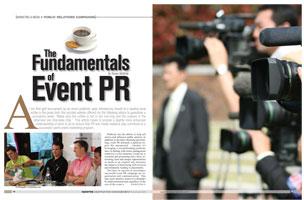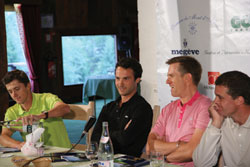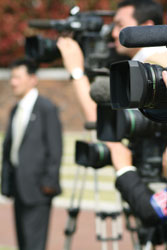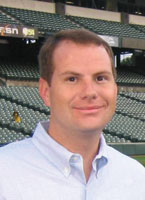
At my first golf tournament as an event publicist, upon introducing myself to a leading local scribe in the press tent, this grizzled veteran offered me the following advice to guarantee a successful week: "Make sure the coffee is hot in the morning and the cookies in the afternoon are chocolate chip." This article hopes to provide a slightly more enhanced understanding of what to do to ensure that PR and media relations play contribute to a successful sports event marketing program.
 Publicity has the ability to help tell stories and influence public opinion. In addition to the basic blocking and tackling, event PR demands a publicist expect the unexpected - whether it's leveraging a record-breaking performance or dealing with issues management related to a crisis situation. Creativity is essential and presenting story lines, interesting facts and unique opportunities to media in an original way increases the chances of them being well received and ultimately leading to placements.
Publicity has the ability to help tell stories and influence public opinion. In addition to the basic blocking and tackling, event PR demands a publicist expect the unexpected - whether it's leveraging a record-breaking performance or dealing with issues management related to a crisis situation. Creativity is essential and presenting story lines, interesting facts and unique opportunities to media in an original way increases the chances of them being well received and ultimately leading to placements.
Two keys to success in executing a successful event PR campaign are organization and communication. This may seem intuitive, however it shouldn't be underestimated and regardless of the size of the event a high-level of preparation and the ability to cover all details is a key measure of success. Thus, it is important to establish both a detailed plan covering all aspects of the event, from media strategy to results reporting to crisis communications as well as a simple checklist that outlines all the necessary "to-dos" to ensure every aspect of the event is covered from a PR perspective.
The sports publicity world is all about building relationships. As an event publicist one needs to be able to build them and leverage them to meet the event marketing objectives. Realize that the media one meets when you start out your career (or when they start out theirs) may also be the same people you work with later in your career and/or they can ascend to significant positions - today's online blogger can be tomorrow's beat writer or even national columnist. This mindset can help the event publicist overcome some of the minor frustrations and challenges that is inherent in working with a wide range and large number of media on a daily basis.
A good rule of thumb for interacting with media is to treat them as clients - be a resource to them and provide flawless service. Familiarize yourself with what they are writing about or covering and develop a sense of what they are looking for in a story. This is especially important if you are publicizing a niche sport or one that is not of the standard stick-and-ball variety. The fact is, and experience has proven this true, many times reporters can be assigned to cover sporting events they have no familiarity with and the best shot at success a publicist can have is positioning oneself as their "go-to" person. As a result, you need to have a high level of knowledge of every aspect of the sport and a firm grasp of the fundamentals to be able to be credible with the media, much less the competitors and officials, with whom you must also develop strong relationships.
Advance publicity and coordination is key. Often, events that focus on individual athletes, such as golf and tennis, need as much if not more publicity to drive awareness, sponsorship and ticket sales in advance of the event, than they even need during the event focused on competition results. Creating an annual PR plan, with a focus on a two-to-three month period leading up to the event that accelerates PR activities is a standard practice. The creation of events or moments-in-time such as media days, event and sponsor-related stunts, conference calls with spokespersons or competitors, sponsorship announcements, etc. can fill in this calendar.
Also, gain a sense of where your event fits in the local community and identify elements that can be showcased or moments-in-time you can stage that tie your event to the community. Identify local issues that your event can potentially address; things like at risk children or bringing sport to deprived or underprivileged children or filling any kind of gap. Attempt to answer the question: how does your event support the community in which it takes place and why should the community likewise support your event?
As a result of variables outside of a publicist's control (weather, athlete withdrawals, etc.) the more advance publicity one can execute, the better it is from an event promotion perspective and the less risk for a publicist from a success standpoint. The PR "stunt" continues be an effective way to overcome the challenge of breaking through the proverbial "clutter". No matter what approach may be taken or how outrageous an idea might be there still needs to be a plan to get media coverage. The stunt should also be recognized as just the starting point of an engagement with the media - dealing with the media before and especially after that event, is of the utmost importance.
Playing "follow the leader" isn't always a bad idea, either. Repeating (and perhaps enhancing) effective media events and best practices that have been executed by other events in other markets can prove to be a trusted way to engage fans and garner some attention.
 One of the biggest challenges in executing a successful event PR campaign is balancing multiple priorities such as ticket sales, sponsor objectives, charity elements, competition results and broadcast partner needs. An event publicist is in a position where one needs to deal with and service a wide range of people including players and agents, TV partners, sponsors, charity representatives and officials, in addition to the media, and ultimately, the public.In many cases it comes down to the simple fact of remembering who you work for and ensure they get first priority. Everything else can be addressed in order of priority and being able to problem solve, act professionally and pro-actively and find ways to incorporate them into the mix can alleviate a lot of headaches.
One of the biggest challenges in executing a successful event PR campaign is balancing multiple priorities such as ticket sales, sponsor objectives, charity elements, competition results and broadcast partner needs. An event publicist is in a position where one needs to deal with and service a wide range of people including players and agents, TV partners, sponsors, charity representatives and officials, in addition to the media, and ultimately, the public.In many cases it comes down to the simple fact of remembering who you work for and ensure they get first priority. Everything else can be addressed in order of priority and being able to problem solve, act professionally and pro-actively and find ways to incorporate them into the mix can alleviate a lot of headaches.
Often times, an event publicist's best resource with the media are the athletes participating in the competition. It is the publicist's job to find something about their event that makes it different and interesting to people who are not directly involved. A tried and true approach is identifying the "human interest" angle among the participants. Sometimes "going off the sports page" can be a productive strategy as well. Showcasing charitable elements of your event, publicizing sponsorship announcements and placing calendar listings are all approaches that typically find a home outside the sports section of a newspaper.
When selecting a spokesperson to interface with media, keep in mind who might be of interest and resonate with media - who they may want to hear in addition to or in place of yourself or an event director. As a result, integrating a representative of a title sponsor, a returning champion, legend of the sport or competitor with local ties are all good options and will provide media several angles on which to cover your event.
However, when dealing with competitors the question is always timing and exposure, and finding the right mix. The key to success is understanding the competitors and working to portray a very positive and accessible image to sponsors, fans, and the media. To be successful and maximize media opportunities, a publicist needs to be able to promote both the elite and marquee name athletes as well as up-and-comers and local heroes.
Finally, and perhaps most importantly of all, don't forget to track your media coverage - sponsors are looking for value for their involvement and earned media impressions are an important output from a sponsorship relationship. And while current sponsors will most certainly expect to see an overview of media coverage as part of an event recap, your marketing partners will also need these results as they undertake their hunt for additional sponsors and the continued growth of your event. And don't forget about the coffee and the cookies...

